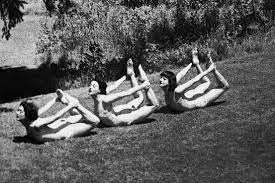False Advertising and The Changing of Yoga for Social Norms

The next two chapters in The Great OOM really stand out to me as a turning point for the Tantriks, Bernard, and even yoga itself. As they move to Nyack and become more visible, the way Bernard begins to speak about what they do as a group changes – “yoga” has to be manipulated and changed in the face of current social norms to avoid it being lost altogether.
As the Tantriks began to move onto the grounds at Nyack, it took “less than a week for this small town to work itself into a moral panic.” Bernard’s connection to the social elite and also his record and reputation had preceded him. But, the fact that the “the country club” and all its members poured a lot of money into the community made it easier for police to turn a blind eye. So, on top of the more secret “formal classes” of Sanskrit and breath work still being held, on the surface the community looked like your usual summer club with baseball, dance, music, not to mention the actual “circus” that was started in 1920. There is a clear shift in the way Bernard was presenting “yoga” to the public and even for him there might have begun a shift in his focus from true yoga to the decadence of his current lifestyle.
On the one hand, the actual Tantrik members followed a strict disciplined lifestyle, with Bernard teaching them to “Get a knowledge of yourself, know your weaknesses, organize (your) yoga teachings”. He also reminded them not to get caught up in their own pleasures (Moksha) or to fake it – “We can’t all go through life with Moksha on our faces…We’ve got to produce the conditions that put Moksha on the other guy’s face.” And then on the other hand, Bernard was a master at selling yoga, “continually searching for the latest hook, the untried angle”. Yoga as a practice may not be the most “sexy” or pleasurable. The outcome and byproducts are, but in reality there is work to be done. But then and even now, that is not what general social norms were accepting.
More and more people were drawn to the external promises of parties and performances, physical health and beauty, instead of the serious study of the yoga itself. And as the entanglements with the Vanderbilt family increased and Bernard was once again under the microscope of the authorities, even his desperation to keep going is obvious and he begins to let go of the depth of yoga as well. When the heat was not on, he still claimed a seriousness of philosophy – “what we care for most is pure intelligence” and “Of culturing or controlling ourselves or increasing our evolution mentally, morally, physically and spiritually”. But, when an official interrogation on his practices by news media or authorities takes place he backs off, saying “We are purely a recreational club, a sort of Summer colony.”
The shift for yoga and the type of interest America takes in it at this time is also exemplified by Love, the author, in the following couple of examples: an actual Indian swami, Yogananda, came to New York to set up a yoga institute less than an hour away from Nyack and the Tantriks and after only a year gave up and went back to India, and though Parahamsa Yogananda (author of Autobiography of a Yogi) and Bernard did cross paths, the emphasis on body culture and Hatha Yoga alone to the traditional Indian was a put-off and they parted ways.
This changing of the focus of yoga has happened over and over as it has made its way to America. Even BKS Iyengar himself took the route of physical focus to make yoga more appealing to the American obsession of the body. And though his full teachings did stress Patanjali’s Yoga of the 8-limbs and the strong discipline it takes to achieve the mental and spiritual heights of yoga, this is “lost in translation” when the body becomes the most obvious tool of a “general class” taught in a gym. You have to take the time to read his writings and listen to his talks instead of just going to an asana class to get “the whole story”. Yoga’s definition changes over time when we are more interested in spreading the subject and “selling it” rather than keeping its true form.
Today’s social norms aren’t much different in their changing of the depth of yoga. The culture of “instant gratification” and the loss of any real focus on expertise and long-term study, where everyone is their own expert and knows best no matter what (thanks Google), the foundational assumptions of yoga are not appealing! 1) our own minds are mistaken most of the time and we are most attached to things that lead us away from our True Nature 2) there are obstacles around every corner and you have to be very aware and disciplined to truly find the actual deep, unchanging, inner abiding peace that yoga promises 3) body perfection and sensual pleasures are not the goal. Bummer.
So, the false advertising continues to make yoga more appealing and “sexy”…to have a country club vibe instead of a place for learning and study. It is fortunate and unfortunate all at the same time. “Yoga” does continue to spread, but what is this “yoga” ?? What is lost when we want an ancient practice to fit our modern norms instead of looking deeply at the actual truths held within?